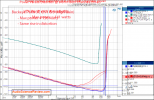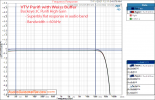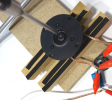Regarding the use of steel/iron in binding posts (BP), there are interesting measurements in the
Buckeye 3 Channel Purifi Amp review thread (thanks
@Rick Sykora).
There, when using steel in the amp binding post, a slight increase in distortion at high loads was found.
...binding posts, the tab is primarily made of steel. Steel is a relatively poor conductor and like a loose or oxidized connection can cause distortion
More
details can be found in this post from
@Rick Sykora.
To see how big the impact of the steel binding posts (BP) are, I compared the Buckeye implementation of the Purifi amp modules to a random other implementation of the Purifi modules -
VTV Purifi Amplifier Review with Weiss Buffer.
The most significant effects on distortion occur at high power levels and 4 Ohm impedance dummy load:
Far less distortion increase with 8 Ohm impedance dummy load:
 What do these findings mean in relation to this thread about speaker binding posts?
What do these findings mean in relation to this thread about speaker binding posts?
1. Costs of binding posts without steel
The 6$ binding posts used in the review were not made of steel, but brass. So it is no problem to get inexpensive BP without steel. If you are unsure whether your BP is made of steel, you can check it with a magnet.
2.

my BP contains steel, how significant is the sound benefit if I abandon them in a dark street corner for high end BP without steel?
The most important question is, does the steel in the BP significantly change the frequency response in the audible range? The answer is no, the measurements made in the
opening post show that the influence is minimal and very likely inaudible (<0.1 dB).
The same is shown by the comparison of the frequency response measurements for the two Purifi amps with and without steel BP (I had to shift the curves a bit against each other so that one could recognize at all that they are each three measurement curves):

The different frequency response curves are congruent.
Regarding distortions, see under 3.
To answer the question very specifically, for "inexpensive, basic" speakers, a little steel in the BP has so little effect that it's not worth replacing the BP - IMHO.
With high quality speakers I would replace steel BP, not because I would expect any sound differences, but to keep possible "errors" in playback as small as possible (even if they are inaudible).
3. Why didn't you notice the increase in distortion when using steel BP (made of nails) in your measurements? Loser!
As can be seen above (green arrows in power vs. distortion diagram above), a noticeable increase in distortion only takes place from about 20W power and more.
At 20W the difference in THD+N is -97dB (0.0014%) to -107dB (0.00044%). This is not measurable on an actual speaker itself, since no speaker shows such low distortion at 20W.
The 20W amp output corresponds to a sound pressure level of 100dB with the tweeter I used for my binding post tests. If the distortion only becomes noticeable at this output power, there is no chance to measure it with a driver - there is no driver that has less than 0.00044% THD+N at 100dB SPL.

Even for a loudspeaker with a sensitivity of only 84dB@2V@1m, 20W amp power means a sound pressure level of 94dB@1m. A very good speaker has at 94dB SPL in the mid and high range down to 0.1% THD, so the additional 0.0014% THD+N by the BP does not matter.
The tweeter used has less than 0.32% THD above 5kHz at 2.83V (about 90dB) and about 1% THD around 2kHz.
Therefore, it is not possible to measure such small THD changes as occurred with the different amp BP.




